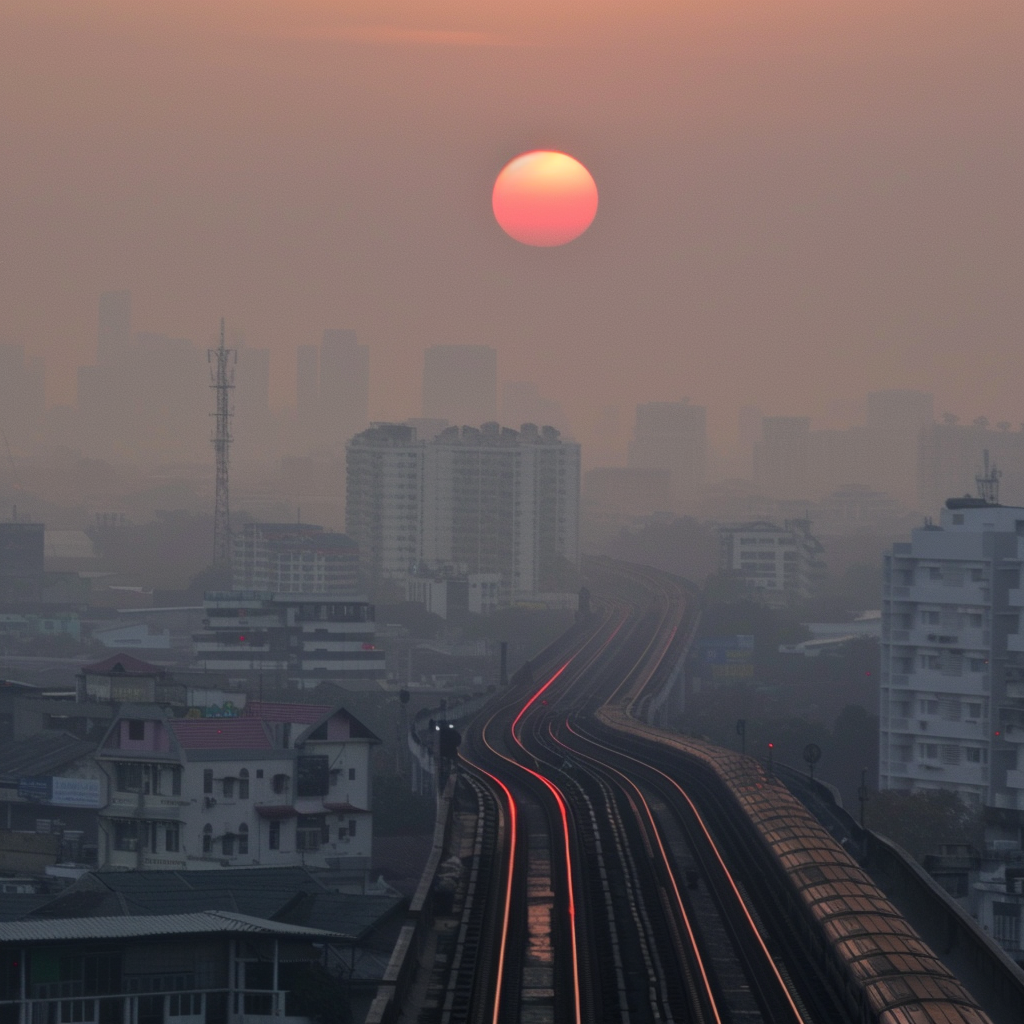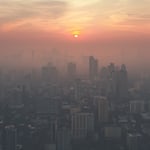Picture a morning bathed in the gentle golden light of the rising sun, with the distant skyline of Nonthaburi province barely visible, cloaked as it is by a thick, pressing blanket of smog. This was the scene captured from Bang Rak Noi Tha It station on the Purple Line, deep in the heart of Nonthaburi’s Muang district. It’s a place where the air, thick with ultrafine dust, seemed almost to ripple with menace.
On a Tuesday morning, the air quality was anything but a picture-perfect postcard. In fact, unsafe levels of ultrafine dust particles blanketed an alarming 70 out of 76 provinces across Thailand, with Greater Bangkok bearing the brunt of this invisible threat. The day began with a report from the Geo-Informatics and Space Technology Development Agency (GISTDA) at 7 am, highlighting the presence of particulate matter that was 2.5 micrometers and smaller in diameter, referred to as PM2.5. These particles were at red-alert levels, deemed hazardous to health, in 27 provinces, particularly concentrated in the central regions.
If you imagined a leaderboard of air pollution, Samut Sakhon province, just west of Bangkok, was unfortunately leading, with a staggering PM2.5 level recorded at 144.8 micrograms per cubic meter. Hot on its heels, the bustling streets of Bangkok registered 125.1µg/m³, followed closely by Nakhon Pathom with 119.3µg/m³, Nonthaburi at 116.3, and then the industrial hub of Samut Prakan showing 115.3. It didn’t end there; Samut Songkhram reached 109.4, Pathum Thani followed with 108.4, and so the grim tally went, echoing a relentless list of towns gasping under the weight of pollution.
Beyond these staggering figures, fifteen more provinces were found languishing with PM2.5 levels that sat ominously within the two-digit red zone, from 75.4 to 95 µg/m³. In order from most to least affected, these included Lop Buri, Chon Buri, Phetchaburi, Saraburi, and Suphan Buri, right down to Prachuap Khiri Khan. It was a stark reminder of the pervasive challenge at hand. The officially sanctioned safe threshold, after all, is ideally a mere 37.5µg/m³.
Yet, not all provinces were immersed in this haze. Seven provinces seemed to breathe a little easier. Phangnga, Surat Thani, and Chumphon, for instance, boasted moderate air quality, with PM2.5 levels flirting around the early thirties—32.2, 32.1, and 29.7, respectively. On the brighter side, some corners of Thailand, like Krabi, Chiang Rai, Chiang Mai, and Mae Hong Son, enjoyed the best of nature’s respirations—achieving air quality metrics of 24.9, 24.6, 21.4, and a refreshingly crisp 12.4.
However, the story wasn’t entirely rosy. There were still 43 provinces precariously balanced on orange-level alerts, with PM2.5 concentrations stretching from 37.7 to 75µg/m³, teetering on the brink of health advisories.
As the day unfolded, bringing with it a promise of either renewal or perpetuation of this smog-bound reality, citizens are left contemplating solutions and adaptations. The struggle for cleaner air is palpable—a mix of policy needs, individual action, and a collective call to nature’s better angels could be the only salvation from this shroud.


















The smog in Nonthaburi is more than just a crisis, it’s a public health emergency! The government has to act now!
Sure, Joe, but what can they actually do? Policies take time, and there’s no quick fix for air pollution.
Larry’s right! Plus, a lot of this is due to industrial pollution. Are they willing to cut down profits for clean air?
It’s not just about policies, it’s personal responsibility too. People need to make environmentally friendly choices!
Can you imagine kids playing outside in that kind of air? It’s a lawsuit waiting to happen against big corporations.
Are we seriously going to blame companies for everything? Individuals need to do their part too!
Ethan, while individual action is necessary, systemic change is crucial. Corporations contribute massively to pollution.
Joe’s right. It’s a collective problem, needing collective action like stricter regulations on industries.
I live in one of those provinces with the ‘good air’. Gotta say, I count my blessings every day.
Why aren’t more people using public transportation? That’d help a lot with emissions!
Tommy, lack of convenience and coverage is why. It’s not feasible for many to rely solely on public transport.
The air pollution levels are insane! Is there any point in even wearing masks when it’s this bad?
Inaction will only cost more in health costs down the line. Prevention is better than cure!
Ken, isn’t that the truth? Healthcare won’t be able to keep up if we don’t solve this.
Exactly, Ken! How many more statistics do we need before we take serious steps?
Isn’t it about time electrics replace the combustion engines to cut down on pollution?
It’s outrageous how little the government has done. This could have been prevented!
Chen, hindsight is 20/20. Efforts are ongoing, but it’s a huge, slow-moving machine.
I think charging a pollution tax on the biggest polluters could be a way to drive change.
My breath is literally hurting in Samut Sakhon. I want to leave but can’t afford to. Helpless!
Ashlynn, that’s horrible! The government should help relocate people stuck in hazardous areas.
There needs to be more investment in renewable energy sources, not only for climate but for our health.
Renewables are the future, George, but the transition period is going to be tough.
The WHO should intervene if it’s this bad! International pressure might wake local governments up.
I heard some countries in Europe have similar issues but handle them better. Maybe we can learn from them?
Sure, but Thailand’s context is different. Solutions need to be localised, not just copied.
It’s sad that we have to even think about the air quality, something so fundamental to life.
Is everyone prepared to pay the cost of healthier living environments? Green solutions aren’t cheap.
Celeste, cheaper than the cost of hospital visits and long-term health issues!
Agreed, Larry. At some point, not solving it will be more cost-intensive than fixing it.